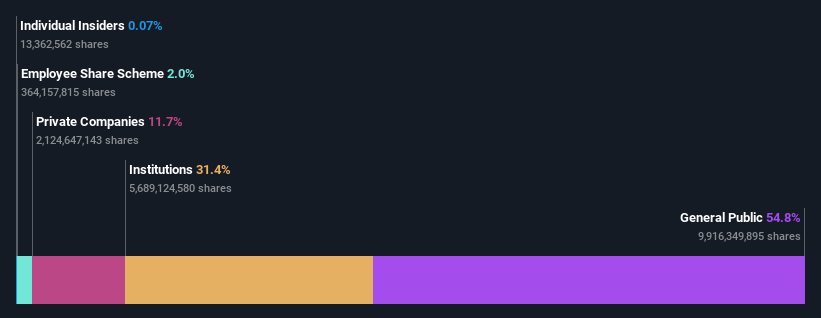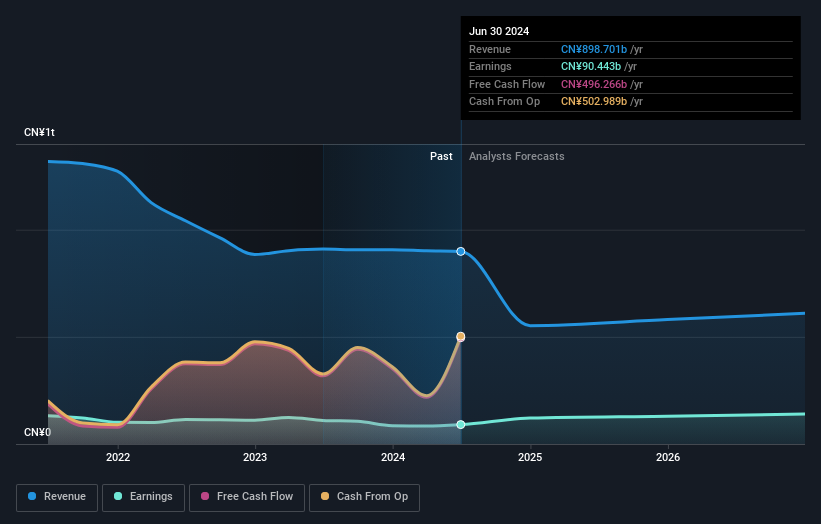Ping An Insurance (Group) Company of China, Ltd. (SHSE:601318) most popular amongst retail investors who own 55% of the shares, institutions hold 31%

Key Insights
- Significant control over Ping An Insurance (Group) Company of China by retail investors implies that the general public has more power to influence management and governance-related decisions
- The top 25 shareholders own 36% of the company
- Institutional ownership in Ping An Insurance (Group) Company of China is 31%
A look at the shareholders of Ping An Insurance (Group) Company of China, Ltd. (SHSE:601318) can tell us which group is most powerful. With 55% stake, retail investors possess the maximum shares in the company. That is, the group stands to benefit the most if the stock rises (or lose the most if there is a downturn).
And institutions on the other hand have a 31% ownership in the company. Insiders often own a large chunk of younger, smaller, companies while huge companies tend to have institutions as shareholders.
Let's delve deeper into each type of owner of Ping An Insurance (Group) Company of China, beginning with the chart below.
See our latest analysis for Ping An Insurance (Group) Company of China

What Does The Institutional Ownership Tell Us About Ping An Insurance (Group) Company of China?
Institutions typically measure themselves against a benchmark when reporting to their own investors, so they often become more enthusiastic about a stock once it's included in a major index. We would expect most companies to have some institutions on the register, especially if they are growing.
Ping An Insurance (Group) Company of China already has institutions on the share registry. Indeed, they own a respectable stake in the company. This suggests some credibility amongst professional investors. But we can't rely on that fact alone since institutions make bad investments sometimes, just like everyone does. If multiple institutions change their view on a stock at the same time, you could see the share price drop fast. It's therefore worth looking at Ping An Insurance (Group) Company of China's earnings history below. Of course, the future is what really matters.

We note that hedge funds don't have a meaningful investment in Ping An Insurance (Group) Company of China. Looking at our data, we can see that the largest shareholder is Shenzhen Investment Holdings Co., Ltd with 5.3% of shares outstanding. With 4.7% and 3.0% of the shares outstanding respectively, Charoen Pokphand Group Co., Ltd. and China Securities Finance Corp, Asset Management Arm are the second and third largest shareholders.
A deeper look at our ownership data shows that the top 25 shareholders collectively hold less than half of the register, suggesting a large group of small holders where no single shareholder has a majority.
While it makes sense to study institutional ownership data for a company, it also makes sense to study analyst sentiments to know which way the wind is blowing. Quite a few analysts cover the stock, so you could look into forecast growth quite easily.
Insider Ownership Of Ping An Insurance (Group) Company of China
The definition of company insiders can be subjective and does vary between jurisdictions. Our data reflects individual insiders, capturing board members at the very least. Management ultimately answers to the board. However, it is not uncommon for managers to be executive board members, especially if they are a founder or the CEO.
Insider ownership is positive when it signals leadership are thinking like the true owners of the company. However, high insider ownership can also give immense power to a small group within the company. This can be negative in some circumstances.
Our most recent data indicates that insiders own less than 1% of Ping An Insurance (Group) Company of China, Ltd.. We do note, however, it is possible insiders have an indirect interest through a private company or other corporate structure. It is a very large company, so it would be surprising to see insiders own a large proportion of the company. Though their holding amounts to less than 1%, we can see that board members collectively own CN¥535m worth of shares (at current prices). In this sort of situation, it can be more interesting to see if those insiders have been buying or selling.
General Public Ownership
The general public -- including retail investors -- own 55% of Ping An Insurance (Group) Company of China. This level of ownership gives investors from the wider public some power to sway key policy decisions such as board composition, executive compensation, and the dividend payout ratio.
Private Company Ownership
It seems that Private Companies own 12%, of the Ping An Insurance (Group) Company of China stock. It might be worth looking deeper into this. If related parties, such as insiders, have an interest in one of these private companies, that should be disclosed in the annual report. Private companies may also have a strategic interest in the company.
Next Steps:
While it is well worth considering the different groups that own a company, there are other factors that are even more important.
I like to dive deeper into how a company has performed in the past. You can access this interactive graph of past earnings, revenue and cash flow, for free.
If you are like me, you may want to think about whether this company will grow or shrink. Luckily, you can check this free report showing analyst forecasts for its future.
NB: Figures in this article are calculated using data from the last twelve months, which refer to the 12-month period ending on the last date of the month the financial statement is dated. This may not be consistent with full year annual report figures.
New: Manage All Your Stock Portfolios in One Place
We've created the ultimate portfolio companion for stock investors, and it's free.
• Connect an unlimited number of Portfolios and see your total in one currency
• Be alerted to new Warning Signs or Risks via email or mobile
• Track the Fair Value of your stocks
Have feedback on this article? Concerned about the content? Get in touch with us directly. Alternatively, email editorial-team (at) simplywallst.com.
This article by Simply Wall St is general in nature. We provide commentary based on historical data and analyst forecasts only using an unbiased methodology and our articles are not intended to be financial advice. It does not constitute a recommendation to buy or sell any stock, and does not take account of your objectives, or your financial situation. We aim to bring you long-term focused analysis driven by fundamental data. Note that our analysis may not factor in the latest price-sensitive company announcements or qualitative material. Simply Wall St has no position in any stocks mentioned.
About SHSE:601318
Ping An Insurance (Group) Company of China
Ping An Insurance (Group) Company of China, Ltd.
6 star dividend payer with excellent balance sheet.


